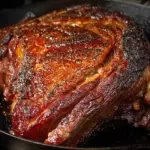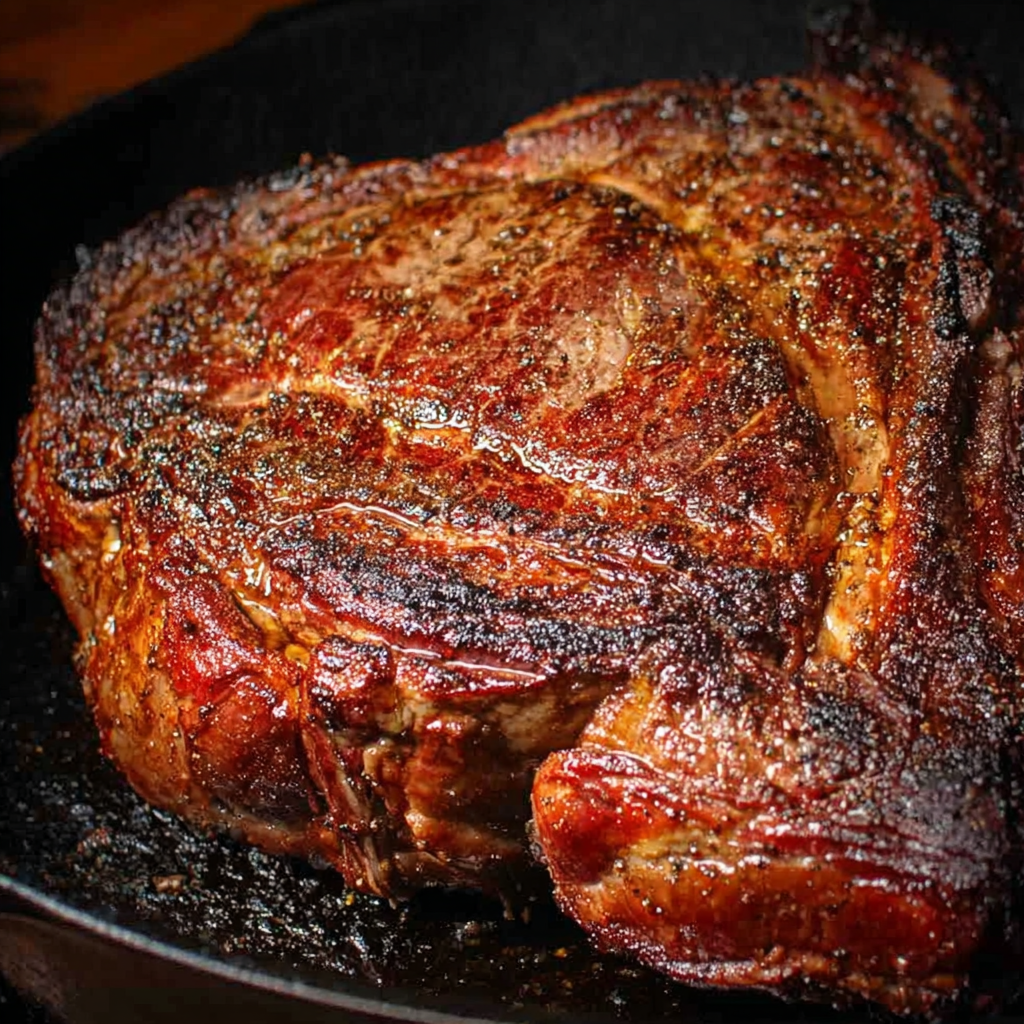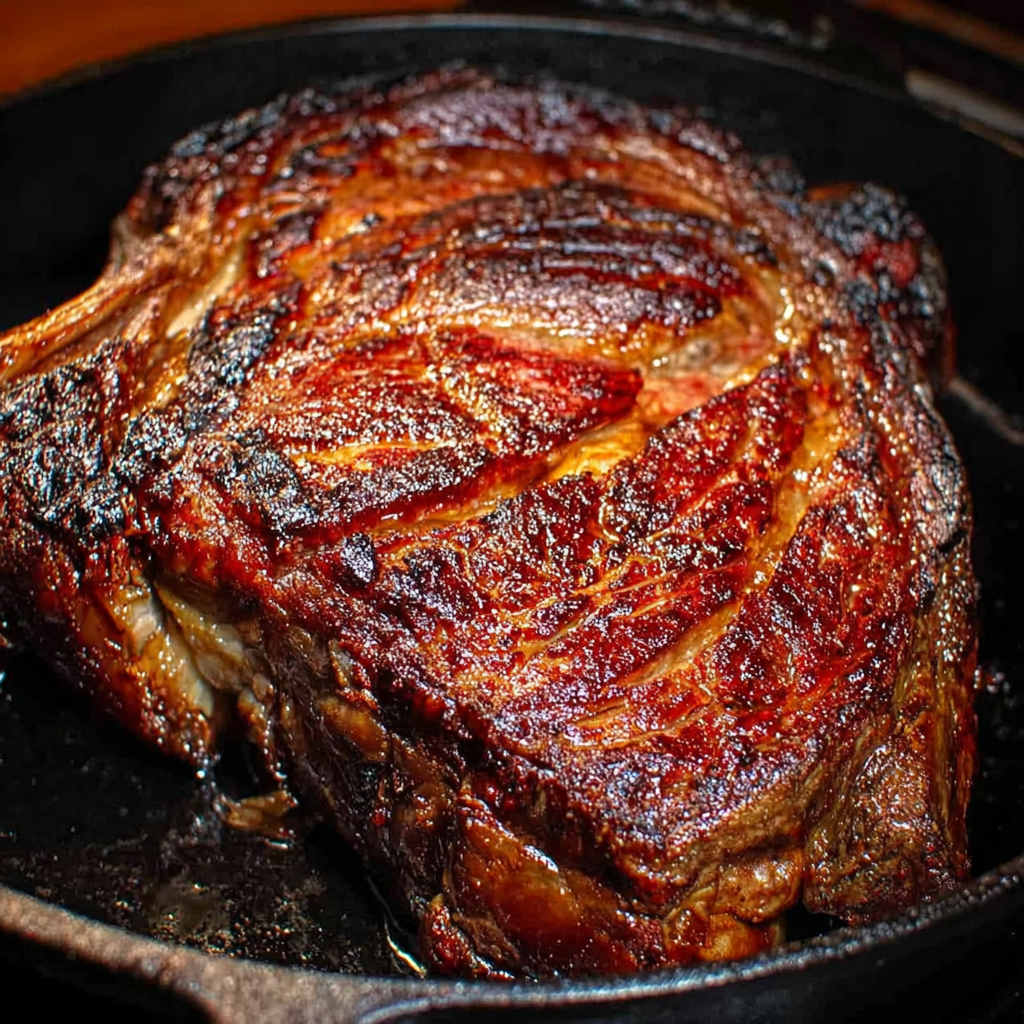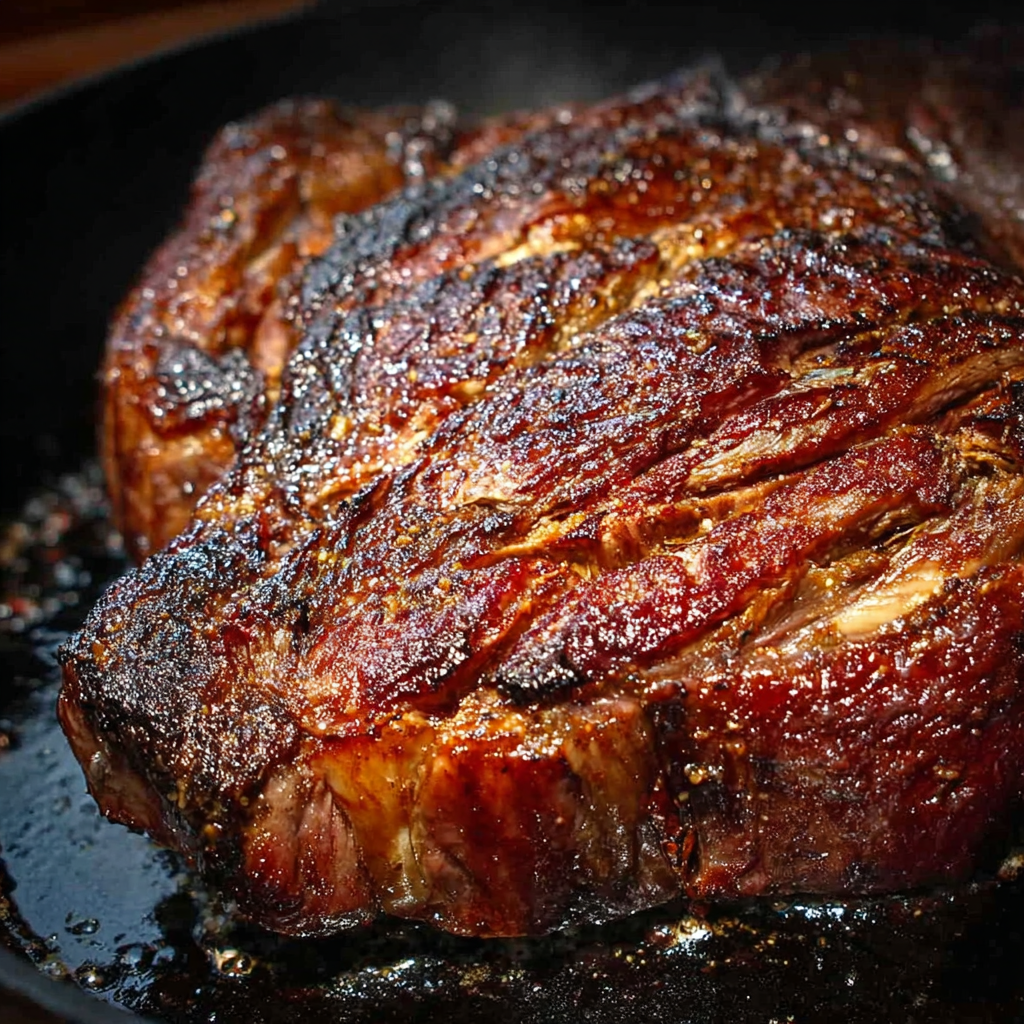Introduction to the Recipe
Few dishes embody indulgence, confidence, and culinary satisfaction quite like the perfect porterhouse steak. Known for its impressive size and unmistakable combination of two cuts—the tenderloin on one side and the strip steak on the other—the porterhouse is a steakhouse favorite that delivers remarkable flavor, juiciness, and texture. Cooking a porterhouse at home may seem intimidating, but with the right technique, it becomes one of the easiest and most rewarding meals you can prepare. This guide will walk you through creating a beautifully seared crust, perfectly pink center, and steakhouse-quality finish using simple ingredients and reliable methods.
A porterhouse steak requires very little embellishment; its natural marbling and generous size make it rich, buttery, and satisfying. High heat, correct seasoning, and proper resting are the keys to success. For cooks who want to better understand steak cuts and differences between T-bone and porterhouse, this resource is extremely helpful: https://www.seriouseats.com/porterhouse-vs-t-bone-steak. If you’re interested in exploring advanced steak-searing techniques, this guide breaks down the science behind perfect crust formation: https://www.cooksillustrated.com/how_tos/9031-pan-searing-steak.
Whether you’re preparing a romantic dinner, celebrating a special occasion, or simply craving a premium steak night at home, this recipe ensures your porterhouse cooks evenly and remains tender on both sides. The straightforward ingredients—olive oil, kosher salt, and black pepper—highlight the deep, beefy flavor without overshadowing it. When cooked properly, the porterhouse delivers the best of both worlds: the tenderness of a filet and the robust flavor of a strip steak.
In this full-length guide, you’ll find everything you need to master the perfect porterhouse steak, including advanced techniques, storage advice, dietary adaptations, FAQs, and a thoughtful conclusion that ties together the beauty and simplicity of cooking great steak at home.
Basic Recipe — Ingredients and Instructions
Print
Perfect Porterhouse Steak Recipe
Description
Make a perfect porterhouse steak with this simple, delicious method for juicy, tender, flavorful results every time.
Ingredients
- 2 (24-ounce) Porterhouse steaks, room temperature
- 1–2 tablespoons olive oil
- Kosher salt
- Freshly ground black pepper
Instructions
- Preheat and prepare: Bring steaks fully to room temperature (30–45 minutes). Preheat a cast-iron skillet or grill to high heat.
- Season generously: Pat steaks dry. Coat lightly with olive oil, then season all sides heavily with kosher salt and freshly cracked black pepper.
- Sear: Place steaks onto hot skillet/grill. Sear for 3–4 minutes without moving them to create a deep crust.
- Flip and sear again: Sear the second side for another 3–4 minutes.
- Finish to desired doneness:
- For 125°F rare: remove earlier.
- For 130–135°F medium-rare: place in a 425°F oven for 4–6 minutes or reduce grill heat.
- Rest: Transfer to a board and rest 10 minutes.
- Serve: Slice against the grain, separating both sides of the porterhouse if desired.
Notes
A dry steak browns better—pat thoroughly before seasoning.
Always use kosher salt, not table salt.
Letting the steak rest ensures juices redistribute evenly.
If your steak is very thick, reverse-searing is an excellent option.
Advanced Techniques
Mastering the Two-Zone Cooking Method
Because a porterhouse has two distinct muscles—the tenderloin and the strip—each cooks differently. Using a two-zone setup allows you to sear over high heat, then finish gently on lower heat so both sides cook evenly. Start by creating a strong crust on each side over direct heat, then move the steak to indirect heat until it reaches your target internal temperature. This ensures the tenderloin doesn’t overcook while the strip reaches perfect doneness. Mastering the two-zone method guarantees a balanced, consistent result every time.
Using the Reverse-Sear for Ultra-Thick Porterhouse Steaks
For steaks over 2 inches thick, the reverse-sear method delivers exceptional results. Start the steaks in a low oven (250–275°F) until they reach 10–15 degrees below your target temperature. This slow heating keeps the interior evenly pink from edge to edge. Once the steak is nearly finished internally, sear in a blazing-hot skillet to create a crisp, flavorful exterior. Reverse-searing prevents a grey band of overcooked meat and results in unmatched tenderness and consistent coloration.
Building a High-Quality Crust Without Burning
The hallmark of a perfect porterhouse steak is a deep, golden-brown crust. To achieve this, ensure your pan is extremely hot—smoking lightly—and avoid overcrowding. A thin layer of oil helps conduct heat, but too much will cause steaming. Press the steak gently into the skillet so the entire surface contacts the heat. Don’t move it prematurely; crust formation takes time. If using butter, add it only during the final 1–2 minutes to avoid burning, spooning it over the steak for richness.
Temperature Tracking and Doneness Precision
Cooking a premium steak demands precision. Use an instant-read thermometer and measure in the thickest part of the strip side. For medium-rare, remove steaks around 130°F—they will rise during resting. Always account for carryover cooking: large steaks like porterhouse can climb 5–10 degrees after leaving the heat. Taking the steak off at the right moment prevents overcooking the tenderloin side. Keeping these temperature nuances in mind ensures flawless results every time.
Enhancing Flavor with Compound Butters and Aromatics
While a porterhouse shines with simple seasoning, adding aromatics enhances depth. Near the end of cooking, add garlic cloves, rosemary sprigs, thyme, or shallots to the pan. Baste with butter to infuse these flavors into the crust. For serving, top with compound butters such as garlic herb, blue cheese, or roasted shallot butter. The heat of the steak melts the butter into a luxurious sauce that complements its natural richness without overwhelming it.

Storage, Shelf Life, and Maintenance Tips
Refrigerating Cooked Porterhouse Properly
After cooling slightly, store leftover steak in an airtight container or wrap tightly in foil. Refrigerate for up to 3 days. To prevent drying, add a small piece of butter before sealing. When reheating, avoid high heat; slow reheating maintains tenderness. A skillet over low heat or a 250°F oven works best. Leftovers remain great for steak salads, sandwiches, or breakfast hash.
Best Freezing Practices for Maintaining Quality
You can freeze cooked steak for up to 2 months when wrapped tightly in plastic wrap, then foil, and stored in freezer bags. Freeze slices rather than whole steaks for faster reheating. Thaw overnight in the fridge, then warm gently. Avoid microwave reheating, as it toughens the meat. Vacuum sealing significantly extends freezer life and preserves texture.
Reheating Without Losing Tenderness
Porterhouse leftovers can become chewy if overheated. To reheat properly, use a low-and-slow method. Warm in a 250°F oven until the internal temperature reaches about 110°F. Then give it a quick 30-second sear in a hot skillet to refresh the crust. This mimics the reverse-sear process and keeps the steak juicy.
Storing Raw Steaks Safely
Porterhouse steaks should be used within 3–5 days of purchase. Keep them in their original packaging until ready to season. If storing longer, freeze immediately. For dry aging at home (short-term aging), place steaks uncovered on a rack in the refrigerator for 24–48 hours. This helps dry the exterior, resulting in better browning.
Repurposing Leftovers Creatively
Leftover porterhouse makes excellent gourmet meals. Slice thinly for sandwiches, quesadillas, or steak tacos. Use chunks in beef fried rice, steak and eggs, or pasta dishes. Add slices over salads with blue cheese dressing for a steakhouse feel. Reuse gently so the steak stays tender.

Dietary Adaptations and Substitutions
Low-Sodium Version
Since porterhouse gains most of its seasoning from kosher salt, reducing sodium requires adjusting technique. Use less salt and boost flavor with black pepper, herbs, garlic, and butter basting. A cast-iron sear enhances savory notes even with minimal salt. For a finishing touch, a small squeeze of lemon brightens flavor without sodium.
Keto-Friendly Modifications
This steak is naturally keto. Serve with butter, garlic herb sauce, or sautéed mushrooms. Pair with low-carb sides like roasted broccoli, spinach, or cauliflower mash. Avoid added sauces that contain sugar. The high fat content fits keto diets perfectly.
Dairy-Free Option
The basic steak is already dairy-free. Simply avoid butter for basting and use olive oil or beef tallow. Fresh herbs and garlic provide excellent richness without dairy. Serve with dairy-free chimichurri for added flavor.
Gluten-Free Adaptation
This recipe is naturally gluten-free. Just avoid seasoning blends with hidden gluten. Serve with gluten-free sides like potatoes, vegetables, or rice. If using compound butter, check that flavorings are gluten-free.
Leaner Alternative Cuts
If you want a lighter option, use sirloin or flat-iron steak and follow the same cooking method. While not identical in flavor or marbling, these cuts still sear beautifully and offer a healthier profile with less saturated fat.

FAQs About the Recipe
Is a Porterhouse the Same as a T-Bone?
They are similar but not identical. A porterhouse includes a larger tenderloin section, making it more premium. A T-bone has the same shape but a smaller filet. Both contain strip steak on one side and tenderloin on the other, separated by the characteristic T-shaped bone. For presentation and size, porterhouse is favored for special occasions.
Why Must the Steak Be Room Temperature?
A cold steak cooks unevenly. Bringing porterhouse to room temperature ensures the interior warms slightly before searing, reducing the risk of an overcooked outside and undercooked interior. Room-temperature meat also forms a crust more easily because moisture evaporates quickly on the heat.
How Do I Know When It’s Done Without Cutting Into It?
Use an instant-read thermometer inserted into the thickest part of the strip side:
- 125°F rare
- 130–135°F medium-rare
- 140°F medium
Porterhouse continues cooking after removal, so take advantage of carryover heat. Avoid cutting into the steak, which releases juices prematurely.
Why Is My Crust Pale Instead of Brown?
Several factors prevent browning: insufficient heat, too much moisture on the surface, or overcrowding the skillet. Pat the steak completely dry and ensure the pan is smoking hot. Use a cast-iron skillet and avoid frequent flipping. Oil lightly; too much inhibits browning.
Can I Grill Instead of Pan-Sear?
Absolutely. Grilling adds smoky flavor and beautiful grill marks. Use a two-zone setup and sear over direct heat, then finish on indirect heat. Thick steaks benefit from reverse-searing as well. Let rest before slicing.

Conclusion & Final Thoughts
Cooking the perfect porterhouse steak is a rewarding experience that transforms simple ingredients into an elevated dining moment. With just olive oil, salt, and pepper, you can coax out the rich, beefy flavor that makes porterhouse one of the most beloved steakhouse cuts. Whether cooked for a celebration, a special weekend dinner, or simply a craving for something extraordinary, this steak brings both satisfaction and elegance to your table.
One of the reasons porterhouse is exceptional is its dual personality—tenderloin on one side, strip steak on the other. Learning how to cook both simultaneously is a valuable skill, and this guide equips you with techniques that ensure even cooking, a gorgeous sear, and consistent juiciness. By mastering temperature control, crust building, and proper resting, you can achieve restaurant-quality results with ease.
This recipe is also highly adaptable. Whether you prefer pan-searing, grilling, or reverse-searing, each method highlights different aspects of the steak’s flavor. The simple seasoning allows the natural beefiness to shine, while optional finishing touches—herb butter, garlic basting, or aromatic herbs—offer personalized flair.
What truly makes this dish special is its ability to bring people together. A porterhouse is naturally generous, making it ideal for sharing. Carving it tableside adds an impressive touch that enhances the dining experience. With proper technique, the perfect porterhouse steak becomes a reliable showstopper—a meal that feels luxurious yet surprisingly easy to prepare.
Whether you’re new to steak cooking or refining your craft, this recipe provides everything you need to succeed. Enjoy each bite, and savor the mastery you’ve brought to your kitchen.
